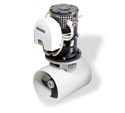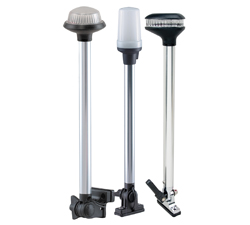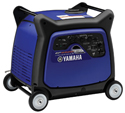Bow Thrusters, Not Just For the Big Boys Anymore

 Some of my first sailing experiences were with my girlfriend's father on his 28' sloop. All went well until we returned to his slip and make that awkward turn to pick up a floating dockline. At that point, my skipper would transform into a red-faced sputtering Captain Bligh while I frantically tried to decipher his yelled instructions.
Some of my first sailing experiences were with my girlfriend's father on his 28' sloop. All went well until we returned to his slip and make that awkward turn to pick up a floating dockline. At that point, my skipper would transform into a red-faced sputtering Captain Bligh while I frantically tried to decipher his yelled instructions.
No question about it, docking can be one of the most nerve racking parts of boat ownership. Not discouraged by my earliest experiences, I purchased a heavy ocean-going ketch and we sailed thousands of miles together, including a transatlantic crossing. I have to admit that my most unsettling moments were not at sea, but around the docks, including a memorable incident in Florida involving a concrete piling and a posh yacht club. With a turning circle like a freighter and negligible reverse, docking in tight spaces was never easy. I'm sure my own experience is no different from boat owners confronted with today's crowded marinas, most of which are designed based on the assumption you can turn your boat around in not much more than its own length and under almost any conditions. Would that it were so!
Not that long ago bow thrusters were found only on large ocean-going vessels or mega yachts; in the last 20 or so years they've become more efficient and compact in design and are now being fitted to smaller boats.
Trailer cruisers such as the Rosborough 246 are often fitted with thrusters; in the case of Ranger Tugs, their 25, 27 and 29 are now all equipped with both bow and stern thrusters. Modern twin outboard installations put the motors so close together that the maneuvering advantage of twins is mostly lost. Companies such as Grady White routinely fit thrusters to their boats. Boatbuilders are realizing that taking the pucker factor out of docking adds immeasurably to boating enjoyment and of course sales. As Don Hood of Imtra (distributors of Side-Power) said to me recently, "Pleasure boating should be pleasurable".
Today, thrusters are increasingly being installed on sailboats. Beneteau's new "Dock & Go" system was a hit at the recent US Sailboat Show in Annapolis. Utilizing a joystick control which synchronizes a pivoting propeller driven base unit with a bow thruster, the 50' demo boat was maneuvering easily in a 60' by 60' space, much to the appreciation of the crowd which no doubt included a large number of nervous dockers.
Installing a thruster on an older boat can be a significant investment. But, how often have you heard of people selling their boats because they don't use them enough. "I only went out 4 times last year and it worked out to $1,000 a trip….". Well if the operation of the boat becomes less stressful, then your family will want come along, you'll use the boat more and the dollars per hour of boating will go down. A boat tied to a dock is really a poor investment.
Graham Toms of Payne's Marine (distributors of Lewmar) says he has been selling thrusters for boats as small as 25 ft., although most are in the 30-40 ft. range. Graham points out that it is important to discuss your needs with the installer to be sure your boat has enough room. Some boats, both sail and power, do not have sufficient depth forward for the thruster tunnel, which needs to be at least 1.5 times its diameter below the surface. If this is not possible, one of the retractable thruster units may be the answer.
Another issue is your boats' electrical system and battery capacity. Electric thrusters are power hungry critters and usually require dedicated batteries. If these can be located close to the thruster, so much the better to avoid long lengths of heavy cable. Have your installer inspect your boat and if he doesn't ask the right questions perhaps you should shop around a little more.
Here I should mention that while doing it yourself is not out of the range of a very capable boat owner, you are cutting a rather large hole in your boat and this is probably best left in the hands of a professional. Ask around the marina to see what others have experienced with different products and installers. YouTube has some excellent videos showing thruster installation. Viewing these will help you understand just what is involved.
Choosing the right thruster for you boat can be confusing. Make sure you are comparing apples to apples when looking at different units. The length, displacement and style of the boat are all important factors. A low profile express cruiser will use a smaller unit than a boat with a flying bridge, particularly if it has the popular canvas enclosures which create a huge amount of windage. Single or twin prop is another consideration. Most of the smaller thruster units are singles and the propeller is designed to push more thrust over the hub than outwards to compensate for interference. Since the labour for installation is 50-65% of the cost, saving money on the thruster unit itself is a false economy. An undersized unit is both a waste of money and potentially dangerous.
Perhaps the most useful option is a remote control unit. With some practice, single-handed docking can be made easy as the thruster can be used to hold the boat in position while getting lines ashore and secured, thus facilitating a no-jump landing.
Something new from Side-Power is their variable-speed battery powered bow and stern thrusters. These units allow control of the thrust strength which until now, was only possible in bulky and expensive hydraulic thrusters. With variable-speed, the remote control unit can adjust thruster strength in 10deg increments. This allows for low power use of the thrusters to hold the boat in position. Right now these units are targeted at larger yachts as an alternative to hydraulic systems; however we can hope that in the near future this technology will be applied to smaller units. Certainly the direction of the boating industry is to ever more user friendly boats with integrated systems. If these changes get us out on the water more, then the investment will be well worth it.





























